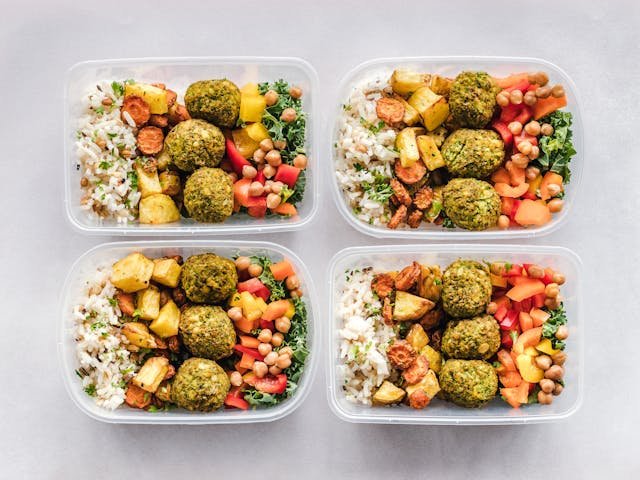- Step 1: Determine Your Daily Caloric Goal
- Step 2: Take a Closer Look at Macronutrients
- Step 3: Identify Foods with Nutritional Benefits
- Step 4: Meal Timing and Frequency
- Step 5: Consume High-Calorie Beverages
- Step 6: Working Out
- Step 7: Keep Record of Your Goals
- Step 8: Solutions for Common Problems
- Sample Meal Plan for Healthy Weight Gain
- Conclusion
Gaining weight can be just as tough as losing it. This is especially the case for individuals with an extremely rapid metabolism, an active lifestyle, or certain medical conditions. While many strive harder to lose weight, weight gain also requires healthy, long-term nutrition that is properly planned. The focus of this guide is to ensure that when aiming to gain weight, it does not negatively affect a person’s health.
Shedding Some Light on the Basics of Weight Gain
On average, a person gains weight when net calories consumed are greater than the net calories burned. However, it is important to note that one metric does not fit all – not all calories are useful. The optimal approach is to incorporate a decent amount of muscle while minimizing fat through a three-pronged approach to nutrition, which ties in rest and strength training.
This formula is vital in ensuring a balance of energy gain for weight gain:
- Calories In > Calories Out: It’s much simpler than people think – you just need to go above your average maintenance calories to ensure you gain weight.
- Quality Matters: Rather than focusing on junk foods such as soda and candy bars, it is essential to prioritize whole, nutrient-dense foods.
Step 1: Determine Your Daily Caloric Goal
To gain weight, one must first know the number of calories required. This requires calculating the Total Daily Energy Expenditure (TDEE), which includes:
- Basal Metabolic Rate (BMR): The amount of calories that your body burns to maintain everyday functions like breathing and circulation.
- Activity Level: The calories burned from physical activities such as working out or performing daily tasks.
Once the total number of calories needed is calculated, one should consume 300–500 calories above that value. For instance, if your TDEE is around 2000 calories, aim to consume between 2300–2500 calories to encourage muscle growth.
Step 2: Take a Closer Look at Macronutrients
To effectively increase weight, macronutrients must be monitored and balanced:
- Proteins: Required for repairing and growing muscles. Aim to consume 1.2–2.0 grams of protein per kilogram of body weight daily. Great sources include fish, chicken, eggs, tofu, and legumes.
- Carbs: Provide energy for both workouts and everyday activities. Focus on complex carbohydrates such as whole grains, quinoa, oats, and sweet potatoes.
- Fats: Healthy, calorie-dense foods like avocados, nuts, olive oil, seeds, and fatty fish can be included in your meal plan.
Step 3: Identify Foods with Nutritional Benefits
Gaining weight may trigger the idea of buying junk food for additional calories. While tempting, this is not the ideal approach. Instead, eliminate junk food and derive energy from foods that are rich in vitamins and minerals.
High-Calorie, Energy-Dense Foods:
- Nuts and Nut Butters: Peanuts, cashews, and almonds are great sources of calories.
- Seeds: Sunflower seeds, chia seeds, and flaxseeds are high in calories and healthy fats.
- Dairy Products: Foods like cheese, yogurt, and milk are rich in calories, protein, and calcium.
- Oils: Avocado oil, coconut oil, and olive oil are high in healthy fats and calories.
- Whole Grains: Excellent sources of carbohydrates include quinoa, whole-grain bread, and brown rice.
Step 4: Meal Timing and Frequency
Most people struggle with eating larger amounts, particularly those with smaller appetites. Here are some ways to address that problem:
- More Meals: Instead of having three large meals, try having 5–6 smaller meals throughout the day.
- Larger Snacks: Have snacks between meals that are high in calories, such as protein bars, trail mix, or smoothies.
- Frequent Meals: To maintain a caloric surplus, try eating every 2–3 hours.
Step 5: Consume High-Calorie Beverages
If you do not wish to feel overly full, it is recommended to consume beverages high in calories, as they enable you to consume more with little effort. For better options without added sugar, consider the following:
- Smoothies: Blend yogurt, nut butter, and milk with your favorite fruits for a nutritious drink.
- Protein Shake: Combine milk or water with a scoop of protein powder, peanut butter, or banana.
- Whole Milk: Packed with more nutrients and calories than skimmed milk.
Step 6: Working Out
A single timeline on how you wish to use your nutrition is not enough. Strength training is vital to gaining lean muscle over excess fat. Include compound exercises such as:
- Squats
- Deadlifts
- Bench presses
- Pull-ups
These exercises target multiple muscle groups and are ideal for building bulk. It is recommended to work out 3–4 times a week and progressively increase the weight you lift.
Step 7: Keep Record of Your Goals
Keeping track of your goals and measuring progress is crucial. This can help you plan what needs to be done next. Try the following:
- Weigh Yourself Weekly: Aim to gain 0.5–1 pound per week. Faster weight gain may lead to unintended fat accumulation.
- Assess Body Composition: Use tools such as body fat calipers or body composition scales to track changes in muscle and fat mass.
- Food Diary: Record your meals to ensure caloric and macronutrient goals are met.
Step 8: Solutions for Common Problems
Gaining weight isn’t always straightforward. Here are solutions to common issues:
- Decreased Appetite: Choose high-calorie foods, avoid drinking water with meals, and eat several small meals throughout the day.
- Digestive Issues: Avoid excessive fiber intake, and introduce new foods gradually.
- Plateaus: Increase your daily calorie intake by 100–200 calories and vary your training schedule.
Sample Meal Plan for Healthy Weight Gain
Here’s a 3,000-calorie meal plan to get you started:
Breakfast:
- Spinach and cheese omelet with 3 eggs
- 2 slices of whole-grain bread with avocado
- 1 cup of orange juice
Mid-Morning Snack:
- 1 banana
- 2 tablespoons of peanut butter
- 1 protein shake
Lunch:
- Grilled chicken breast
- 1 cup of quinoa
- Steamed broccoli with olive oil
Afternoon Snack:
- 1 cup of Greek yogurt with honey and granola
- A handful of almonds
Dinner:
- Grilled salmon
- 1 sweet potato
- Roasted asparagus
Evening Snack:
- Smoothie with milk, frozen berries, nut butter, and protein powder
Conclusion
Gaining weight in a healthy manner is a gradual process that requires dedication and effort. Your food intake should be nutrient-rich, and you should keep track of your strength training and macronutrients to ensure a caloric surplus. Following the steps in this guide will help you achieve your weight gain goal in a healthy and sustainable way.



